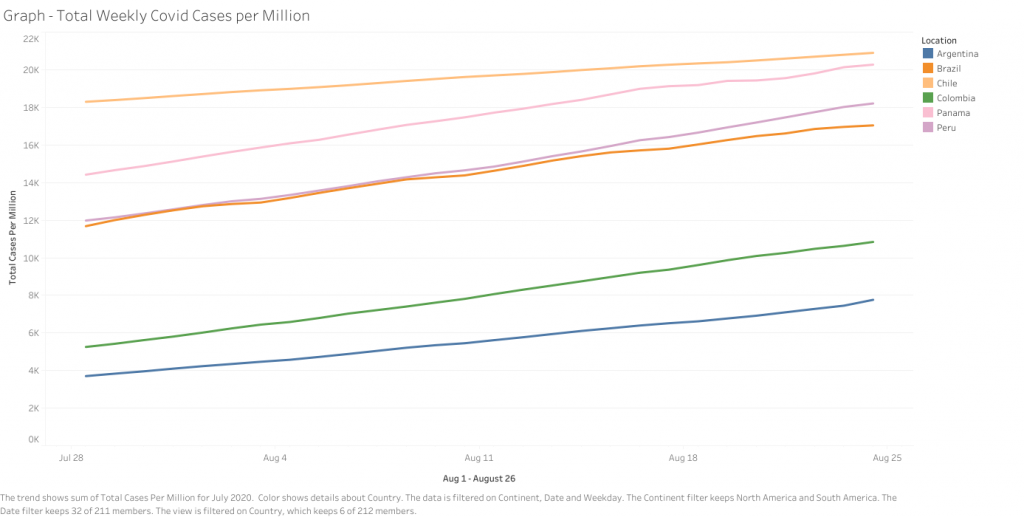Three things to know
- COVID-19 is exerting a multi-dimensional impact on Latin America and the Caribbean, a global epicenter. As of today, the region has confirmed over 263,000 COVID-19.
- Social pressure appears to be mounting, as evidenced by protests in Argentina, Brazil, Bolivia, and Chile.
- A new report by the Economic Commission for Latin America and the Caribbean (ECLAC) and the United Nations Educational, Scientific, and Cultural Organization (UNESCO) warns about the pandemic’s impact on widening the education gap.
By the numbers
- Cases by country: Brazil (3,674,176) #2 worldwide, Peru (607,382) #6 worldwide, Mexico (568,621) #7 worldwide, Colombia (562,128) #8 worldwide, Chile (400,985) #10 worldwide, Argentina (359,638) #12 worldwide.
- Prevalence rate (confirmed cases per million people): Chile (20,949) #4 worldwide, Panama (20,436) #6 worldwide, Peru (18,383) #8 worldwide, Brazil (17,267) #10 worldwide, Colombia (11,030) #21 worldwide, Bolivia (9,490) #25 worldwide.
- Deaths – total reported in the region: Brazil (116,666) #2 worldwide, Mexico (61,450) #3 worldwide, Peru (28,001) #9 worldwide, Colombia (17,889) #10 worldwide, Chile (10,958) #14 worldwide, Argentina (7,661) #18 worldwide, Ecuador (6,368) #21 worldwide.
Quarantine & reopening plans
Colombia, El Salvador, and Mexico continued their reopening plans; Argentina and Bolivia maintained restrictive measures. Education systems face new challenges as some countries begin the new academic year.
- Colombia will lift its general quarantine on September 1, although a sanitary emergency with selective isolation and specific restrictions will remain in place. President Iván Duque announced that this new phase will last until the end of September and will be monitored daily. Bogotá lifted its strict quarantines but warned that activities cannot be fully reinstated.
- In El Salvador, businesses are now operating without restrictions for the first time in nearly six months. This came following the Supreme Court of Justice ruling against a government decree to reopen in five stages. In-person classes at schools and universities are still suspended, while international flights and the tourism sector will reopen on September 19.
- Although Mexico passed 60,000 COVID-19 related deaths, it is on track to record the lowest number of weekly deaths in two months. On August 24, more than 30 million Mexican students began the 2020-2021 remote school year, connecting via TV and radio channels. The pandemic has impacted Mexico’s private schools, which may lose 2 million students at all levels, potentially stretching the public education system.
- Bolivia’s largest mine, a subsidiary of the Sumitomo Corporation, has closed for the third time since March. After one COVID-19 death and 41 confirmed cases, the company decided to suspend operations, affecting more than 1,400 workers.
- In Haiti, teachers are refusing to return to school due to concerns over salary and working conditions under COVID-19. Two weeks after schools reopened, the country has seen sporadic protests in cities like Gonaives, St. Marc, and Jacmel.
Economies in focus
Economic impact
- The International Labour Organization warned that the crisis will have a tremendous impact on vulnerable groups, including women, informal workers, and the young labor force.
- Brazil’s economy may have contracted 9.4 percent during the second quarter in “the worst three-month period ever,” according to a Reuters poll.
- Peru’s economy contracted by 30.2 percent year-on-year in the second quarter of 2020, according to the National Statistics Institute.
- In Argentina, more than 42,000 small and medium-sized enterprises have closed since March, doubling the numbers from the 2001-2002 crisis.
- Mexico’s National Statistics Institute reported a GDP contraction of 18.7 percent in the second quarter of 2020—the worst economic fall in the country’s history. Moody’s forecasted a 10 percent drop in Mexico’s economic growth in 2020.
- El Salvador’s Tourism Ministry reported that the pandemic has cost $1.15 billion in lost revenue.
- Caribbean countries have low infection rates, however, their economies have been severely impacted by the lack of tourism. According to The Economist, the English-speaking islands’ economies may contract by a tenth in 2020.
Public finance and central banks
- Foreign creditors are uneasy about investing in Argentina and Ecuador without macroeconomic reforms and additional International Monetary Fund support. As Ecuador’s deadline to restructure its debt nears, the Trump administration called on the IMF to proceed with a new loan program.
- Bolivia’s executive government and Legislative Assembly seek a compromise over two relief bonds that remain unexecuted. The government is trying to implement the Health Bond, the Legislative Assembly wants to advance the Bond Against Hunger.
Economic relief and recovery
- Nicaragua will receive a $50 million loan from the Central American Bank for Economic Integration to benefit over 700 small and medium-sized enterprises. Despite avoiding the shutdown, Nicaragua faces an economic contraction of 8.3 percent, one of the largest in Central America.
- Brazil’s Ministry of Economy reported a positive employment balance of 130, 031 new formal jobs in July. The first positive balance since February.
- In Chile, rising copper prices have inspired hopes of an economic recovery. On August 19, copper’s price reached $3.02 per pound, the highest price since June 2018.
- In Mexico, there are hopes that post-COVID-19 supply chains transformations will bring investments. Taiwanese phone manufacturing firms Foxconn and Pegatron are reportedly considering investing in the country.
Health and innovation
- Brazil continues to be home to the most Phase III trials in Latin America. The country announced that it would begin Phase III clinical trials, including 6,000 patients, on a COVID-19 vaccine produced by Johnson & Johnson. Brazil will also test a COVID-19 treatment developed by the US pharmaceutical company Sorrento Therapeutics on patients in Rio de Janeiro. The testing must still be approved by Brazil’s health regulatory agency, ANVISA.
- Last week, Argentina and Peru announced that they will both work with China’s Sinopharm to carry out Phase III clinical trials of the company’s COVID-19 vaccine. Peru also announced on August 21 that it is negotiating with six laboratories to acquire 30 million vaccines.
- Many countries are turning their attention to potential costs of a vaccine. If AstraZeneca’s COVID-19 vaccine proves successful, it will be produced “at cost” with each dose sold for $3 to $4.
- On August 24, Cuban authorities and scientists began the human testing phase of a vaccine against COVID-19. The project, called Soberana 01, will conduct trials on 700 people.
A Message from PhRMA:
Innovative biopharmaceutical companies are sharing manufacturing capabilities with each other so that once a treatment or vaccine for COVID-19 is ready, they can get it to millions of people fast. And there’s no slowing down. Biopharmaceutical companies will continue working day and night until they beat coronavirus. More.
Country Focus
- Peru: On August 22, at least 13 people died in the Los Olivos district of Lima, when trying to escape a police raid at a nightclub allegedly violating COVID-19 restrictions. On August 24, Pilar Mazzetti, Peru’s health minister, said that around 40 percent of those living close to Thomas Restobar tested positive in rapid tests.
- Brazil: On August 25, Senator Flavio Bolsonaro, son of President Jair Bolsonaro, tested positive for COVID-19. President Jair Bolsonaro, his wife, Michelle Bolsonaro, and his youngest son, Jain Renan, also had the virus earlier.
- Bolivia: Bolivia’s death toll could be almost five times larger than the official count. Bolivia’s health crisis is compounded by its political crisis, which has further affected medical supply chains and the economy.
- Mexico: On August 22, the government announced that Mexico surpassed 60,000 COVID-related deaths. Nearly three months earlier, Mexico’s COVID-19 tsar, Hugo López Gatell, had considered that figure as a “very catastrophic scenario.”
- Panama: On Monday, nurses began a series of protests to denounce labor conditions during the pandemic. They claim to lack adequate payments and protection equipment. Since the pandemic started, 400 nurses have reportedly contracted the virus.
By the numbers (continued)
- Cases by country (continued): Ecuador (109,030), Bolivia (110,999), Dominican Republic (92,217), Panama (88,381), Guatemala (69,651), Honduras (55,877), Venezuela (41,158), Costa Rica (35,305), El Salvador (25,140). Source: worldometers.info
- Prevalence rate (continued): Dominican Republic (8,488), Argentina (7,946), Costa Rica (6,921), Suriname (6,295), Ecuador (6,166), Honduras (5,628), Mexico (4,403), Guatemala (3,877), El Salvador (3,873), Paraguay (1,991), Belize (1,831), Venezuela (1,448). Source: worldometers.info
- Deaths (continued): Bolivia (4,664), Guatemala (2,630), Panama (1,919), Honduras (1,703), Dominican Republic (1,585), El Salvador (687), Costa Rica (376), Venezuela (343), Paraguay (231), Nicaragua (137), Cuba (91), Uruguay (43), Belize (10). Source: worldometers.info
Quick take


